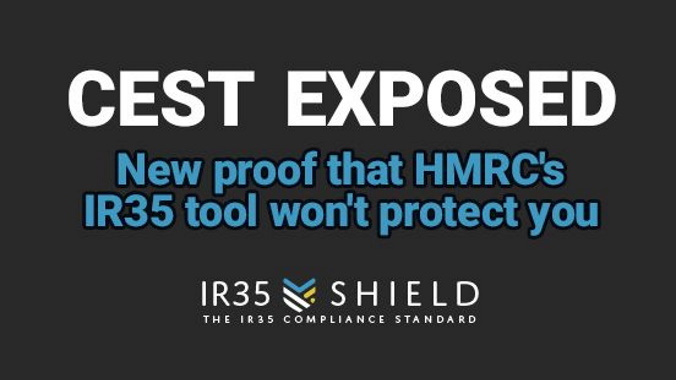Following clarifications and binding law made by the Court of Appeal in the Atholl House IR35 case on 26th April 2022, IR35 Shield has proved that HMRC's Check Employment Status for Tax (CEST) tool contains fundamental flaws exposing users to considerable risk. The evidence compared the failed legal arguments made by HMRC in conjunction with a forensic analysis of the underlying programming code. The findings are unequivocal.
These fresh revelations can be found by examining the CEST source code, version 2.4, released in November 2019 as part of the apparent upgrade to CEST. This speedy upgrade was made only a few months before the planned roll-out of the reforms to the private sector in April 2020. The pandemic then brought about a further one-year delay – but CEST wasn't upgraded further and remained the same.
Dave Chaplin, CEO of IR35 Shield, who presented the objective findings in the comprehensive webinar, says: "Until recently, I'd not looked at the source code since version 1.5.1 and had accepted in good faith that the flaws in the original version had been probably resolved. This was not the case, and the market was duped. CEST was fudged and lulled users into a false sense of compliance.
"In the vast majority of cases, when CEST determines outside IR35, it has not conducted a proper multi-factorial assessment, as the Court of Appeal ruled should be done. Instead, it has relied upon what I term a 'unicorn assessment' – whereby CEST prematurely identifies a contractor as "Outside IR35" based on unrealistic and easily challengeable criteria. This offers no protection for hirers and leaves them significantly exposed."
Atholl House and Ready Mixed Concrete
With no statutory definition of employment, one must turn to the common law to determine employment status. The seminal case, Ready Mixed Concrete from 1968, provides a framework upon which status is determined, consisting of three limbs or stages.
The first stage covers personal service, including mutuality of obligation, and the second stage considers control. After that, the third limb can bring in other factors, where a multi-factorial assessment is then made using a "stand-back" approach – a phrase from a case called Hall v Lorimer.
As the webinar explains in detail, HMRC put forward many arguments within their grounds of appeal, most of which the Court of Appeal disagreed with. For example, Ready Mixed Concrete does not take primacy over Hall v Lorimer, and the extent of the factors considered in the first two limbs should be considered in the third limb, which is not simply a negation exercise. HMRC's arguments were refuted by the Court of Appeal using strong words like "myopic", and HMRC were reminded that common law should not be read like a statute.
Whilst the Court of Appeal found one error in law put forward by HMRC, the majority of HMRC's grounds of appeal failed, demonstrating that HMRC's longstanding policy view on status was flawed.
All of the arguments are explained in the webinar, which is now in the public domain.
Unreliable CEST Unicorn Defence
As the webinar explains, by tracing through the CEST algorithm files, when CEST delivers an "Outside IR35" result, it only does so based on a small number of unrealistic answers and then ignores all other answers given without conducting a full multi-factorial assessment - contrary to binding law from the Court of Appeal.
"HMRC's IR35 tool is essentially just searching for contractor unicorns," says Chaplin. "And if it cannot spot one, it will usually then indicate "Inside IR35" or "Don't know" when it conducts a proper multi-factorial assessment. That's not what the law states, and CEST is provably biased."
Chaplin is also concerned that users are relying on CEST "Outside IR35" determinations, which are based on unrealistic answers, which in his tribunal experience, HMRC will challenge in a heartbeat.
"The unicorns, sadly, won't survive. They are exposed."
Will HMRC fix CEST?
The question now is whether post the conclusions in the Atholl House final judgment, HMRC will update the CEST tool to align with binding law. But, Chaplin indicates in the webinar that HMRC already committed to the Public Accounts Committee on 21st February 2022 that it would keep CEST updated.
Providing witness evidence to the Public Accounts Committee, Nicole Newberry, Director for Wealthy and Mid-Sized Business Compliance, HMRC, told the Committee (Q34): "we have been consistently updating our guidance and the Check Employment Status for Tax tool, "and referring to working with professional representative bodies, "…to really make sure that the guidance takes account of recent case law developments."
Chaplin has no doubt that HMRC will keep its word and update the CEST tool: "Given so many firms are using the tool and relying on CEST for guidance, HMRC will need to update it, and I'm sure they will stick to their word. As the files show, the last update was 24th October 2019, so it's due a refresh since many cases have occurred since then."
Where to view the CEST Exposed Webinar?
The webinar "CEST Exposed: New proof that HMRC's IR35 tool won't protect you" is available to watch on the IR35 Shield website. WATCH WEBINAR – CLICK HERE.
Chaplin adds: "If any firms are using CEST and concerned about their exposure, they can get in touch with the team at IR35 Shield for help."

